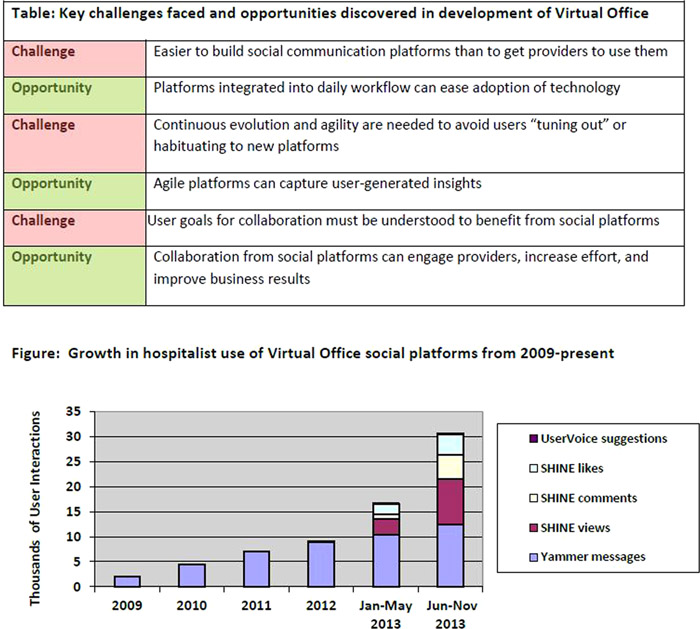Background:
Many hospitalist groups struggle to maintain high engagement of providers. Poor provider engagement can create communication silos and inhibit collaboration. Since hospitalists are accustomed to decentralized networking via the Internet, we created a secure, online social platform integrated with our clinical documentation and billing processes to improve hospitalist engagement in clinical, administrative, and educational issues affecting our group practice.
Purpose:
To improve hospitalist engagement in IPC The Hospitalist Company’s national group practice (about 2,000 hospitalists working at 1,150 facilities in 28 states), an innovative social networking feature was integrated into the group’s online clinical documentation and billing program known as the “Virtual Office” (VO). We measured success of this project by hospitalist use of VO in terms of overall messages posted, specific suggestions for improvement posted, page views, comments, and “likes.”
Description:
IPC first introduced social features into the Virtual Office in 2009 with a web messaging platform called Yammer. Early trends in message content prompted the addition of an online “suggestion box” called UserVoice in 2010 to capture specific ideas for improving the online platform. To date, 12,500 messages have been sent using Yammer and 178 suggestions have been made inUserVoice with 109 solutions implemented by the IT team. The Table below highlights challenges and opportunities identified in early development of VO that informed the completely redesigned “VO2”. Launched in March 2013, VO2 incorporated many popular features of social networking sites including customizeable home pages with news posted to a “wall” which users can “like” or comment on. News topics range from administrative and regulatory issues to clinical practice tips and questions. In the 6 months since the VO2 launch, views per month has tripled (from 3,000 to 9,000/month) with 25,000 total page views, 2,000 likes, and 1,000 comments (see Figure). VO2 also includes a strong educational focus with a searchable, user‐generated catalog of best practices in hospital medicine called Sharing Healthcare Innovation for Nationwide Excellence or “SHINE.” This feature leverages a wiki‐based approach to allow IPC hospitalists to create structured articles on clinical and quality improvement topics that can be updated or improved with colleagues’ comments and suggested edits. We will feature a live demo of V02 social features including SHINE in our presentation.
Conclusions:
IPC’s social strategy has increased provider engagement, helped “flatten” communication silos, and increased collaboration between hospitalists at many levels. These returns on investment have reinforced strong commitment by IPC management to continuous development of VO2 to engage hospitalists in important clinical, administrative, and clinical issues for this large group practice.

